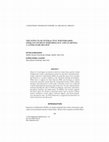Papers by Karen Sobel Lojeski
Uniting The Virtual Workforce, 2015

So far, we've talked a lot about how human qualities and work conditions create Virtual Distance.... more So far, we've talked a lot about how human qualities and work conditions create Virtual Distance. You may be wondering at this point about Virtual Distance and its relationship to the elephant in the room-technology. We include both hardware and software in our use of the word technology, and it's what makes virtual work possible. It's an understatement to say that virtual work has increased rapidly. It's projected, for example, that the percentage of virtual workers in the United States alone will rise to over 15% in urban areas in just a few years. 1 New hardware and software solutions have facilitated this change and continue to be developed at a staggering pace. By the time this book is in print, there will undoubtedly be more new products available to connect us with one another. Trying to make sense of all this is a difficult proposition, but by using Virtual Distance concepts, we can provide a framework for thinking about which solutions may be right for any given set of circumstances and when they can be used most effectively. The key to working together effectively, of course, is communication. The Internet, phone, and audio and videoconferencing have created a diverse set of tools that can be used to facilitate communications and collaborations 161 Uniting the Virtual Workforce: Transforming Leadership and Innovation in the Globally Integrated Enterprise

Mechanical Engineering, 2009
This review explains the concept of virtual distance and its increasing usage in the research and... more This review explains the concept of virtual distance and its increasing usage in the research and development field. Virtual distance occurs when individuals work together and communicate primarily through electronic media. After five years of research, results show that virtual distance is not about geographic distance alone. Instead, it has three major components: physical distance involving differences in space, time, and environment; operational distance including the psychological gaps that arise from day-to-day problems in the workplace; and affinity distance embodying the emotional disconnects among virtual team members who have no relationship with one another. The review also discusses that Techno- dexterity, boundary breaking, globalization, and authenticity are four key competencies effective leaders use to manage virtual distance. It also illustrates the concept of coactivating leaders, which emphasize not only global experience but also the ability to bond with and unde...
Uniting The Virtual Workforce, 2015

Journal of Educational Technology Systems, 2010
Many K-12 and higher-ed schools in both the United States and the United Kingdom have made a subs... more Many K-12 and higher-ed schools in both the United States and the United Kingdom have made a substantial investment in interactive whiteboard technology. Interactive whiteboards (IWBs) are generally perceived by students and teachers as a positive addition to the classroom learning environment. While there is support for links between IWBs and increases in student motivation, questions remain about the relationship between IWBs, student learning, and achievement. In this study a literature review was conducted to better understand the research to date in this area. Several common themes surfaced including the effect of IWBs on pedagogy, motivation, interaction, perception, learning, and achievement. In addition, the research suggests that these effects are related to contextual factors such as teacher training, teacher confidence, school culture, technical support, and lesson preparation and practice time. An IWB framework is suggested and directions for future research are also dis...
Human Resource Development Review, 2011
This article presents a conceptual model of leadership in generative groups. Generative groups ha... more This article presents a conceptual model of leadership in generative groups. Generative groups have diverse team members who are expected to develop innovative solutions to complex, unstructured problems. The challenge for leaders of generative groups is to balance (a) establishing shared goals with recognizing members’ vested interests, (b) maintaining control with empowering members, (c) encouraging exploration with conceptualizing meaning, and (d) taking action with making time for reflection. Propositions suggest how members’ metacognitive skills, member diversity, and electronic modes of interaction influence leadership strategies to maintain balance, develop elements of group-level social cognition, and produce generative outcomes. The article concludes with directions for research and practice.
Asia-Pacific Journal of Business Administration, 2013
Copyright C 2010 by Karen Sobel Lojeski. All rights reserved. Published by John Wiley & Sons, Inc... more Copyright C 2010 by Karen Sobel Lojeski. All rights reserved. Published by John Wiley & Sons, Inc., Hoboken, New Jersey. Published simultaneously in Canada. No part of this publication may be reproduced, stored in a retrieval system, or transmitted in any form or by any ...
Uniting The Virtual Workforce, 2015
Leading the Dispersed Workforce, 2009
By itself, proper software selection cannot resolve the issues created by Virtual Distance. But b... more By itself, proper software selection cannot resolve the issues created by Virtual Distance. But by understanding the dynamics of Virtual Distance teams, organizations can select the right software to provide highly effective critical support and mitigate the inherent risks.
Dynamics that do not exist in face-to-face interactions—including distance, different cultures, a... more Dynamics that do not exist in face-to-face interactions—including distance, different cultures, a wide range of time zones, and communications barriers— mean virtual teams face unique challenges. But there are steps you can take to enhance trust and foster leadership, effective collaboration, and innovation in virtual workgroups.











Uploads
Papers by Karen Sobel Lojeski
This still-evolving Digital Age conundrum continues to present new complications. The rise of remote work which rests on an increasing reliance on electronic communication and the overall growth of virtual interactions has led to the escalation of a phenomenon called Virtual Distance. Virtual Distance, which influences our behavior through three components�Physical Distance, Operational Distance, and Affinity Distance�affects not only how we relate to others thousands of miles away but even to co-workers sitting right next to each other! Perhaps even more problematic, Virtual Distance causes measureable malfunctions in teamwork, innovation, leader effectiveness and overall performance.
But it doesn't have to be this way.
The Power of Virtual Distance offers specific, proven and predictable solutions that can reverse these trends and turn Virtual Distance into a unification strategy to capture untapped competitive advantage.
Surprised?
The Power of Virtual Distance, 2nd Edition is a must-read for leadership who want to understand the true and quantifiable costs of the virtual workplace. For the first time ever, readers can take the guesswork out of managing the virtual workforce by applying a mathematical approach derived from the extensive Virtual Distance data set: The Virtual Distance Ratio. The Virtual Distance Ratio can precisely pinpoint the particular impacts of Virtual Distance on the organization's critical success factors. Beyond business metrics, Virtual Distance solutions also detail ways to restore meaningfulness and well-being into people's experience of work, enhancing life lived in the Digital Age. The Power of Virtual Distance reveals an updated set of data, including the first award-winning analysis, collected from an extended range of executives to individual contributors, that represent situations and solutions in more than 36 industries in 55 countries across the globe. Readers will get a "first look" at the data and its revelations on how to be less isolated and more integrated.
Helping managers globally, this book:
Offers new, real-world case studies and a chance for readers to participate in thought experiments to help with personal performance, group synergy and by extension, relationship dynamics of all kinds Demonstrates (with statistically significant trend analyses) that Virtual Distance is growing at exponential rates in every corner of communities worldwide Offers expert advice on how to manage the "unintended human consequences" of today's digital technologies Companies that successfully harness the power of Virtual Distance demonstrate better performance. The second edition of The Power of Virtual Distance is a valuable, one-of-a-kind resource for everyone - from the C-suite to human resource professionals; from divisional leaders to project managers. Everyone in the organization can benefit by discovering how to improve financials, innovation, trust, employee engagement, satisfaction, organizational citizenship and other key performance indicators. And perhaps best of all, by following the prescriptions on how to reduce Virtual Distance, the entire workforce will have the tools they need to bring about a revival of meaning, purpose and an enlivened sense of "humanhood" back into everyday work and everyday life.